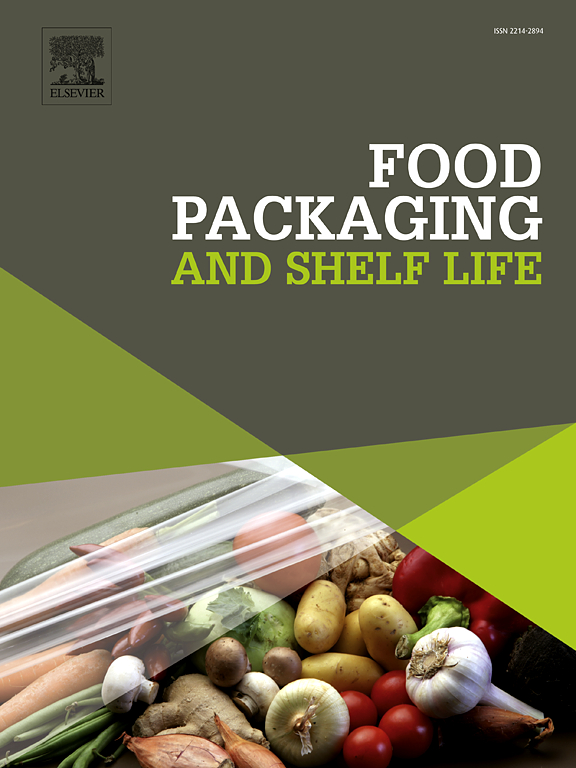添加大豆分离蛋白的蓝莓花青素可生物降解包装膜成膜机理及其在食用菌保鲜中的应用
IF 8.5
1区 农林科学
Q1 FOOD SCIENCE & TECHNOLOGY
引用次数: 0
摘要
以蓝莓花青素(BA)和不含蓝莓花青素(BA)为原料,制备了大豆分离蛋白(SPI)基可食性复合薄膜,并对其进行了表征。成膜液的表征表明,BA与SPI有效结合,增强了成膜液的稳定性。电镜和光谱学分析结果表明,BA能均匀分布并与基体形成氢键。当BA浓度为0.08 %时,薄膜的拉伸强度(TS)和断裂伸长率(EAB)最好。BA的加入也增强了膜的水蒸气阻隔性和抗氧化性。热稳定性分析实验表明,BA的加入提高了膜的热稳定性。热重分析表明,BA的加入提高了膜的热稳定性。在食品保鲜实验中,应用含有0.08 % BA的SPI膜也能明显抑制蘑菇的腐败,延长食品的保质期。研究结果为开发多功能可食用生物包装材料提供了理论基础和数据支持。本文章由计算机程序翻译,如有差异,请以英文原文为准。
Film-forming mechanism of blueberry anthocyanin-added soybean isolate protein-based biodegradable packaging film and its application in edible mushroom preservation
This study aimed at preparing and characterizing soybean isolate protein (SPI)-based edible composite films with and without blueberry anthocyanin (BA). The characterization of the film-forming solution showed that BA effectively combined with SPI to enhance the stability of the solution. The results of electron microscopy and spectroscopy indicated that BA could be evenly distributed and formed hydrogen bonds with the matrix. When the BA concentration was 0.08 %, the tensile strength (TS) and elongation at break (EAB) of the films were the best. The inclusion of BA also enhanced the film water vapor barrier and oxidation resistance. The thermal stability analysis experiment showed that the addition of BA had improved on the thermal stability of the films. Thermogravimetric analysis showed that the addition of BA improved the thermal stability of the films. In food preservation experiments, the application of SPI film containing 0.08 % BA also significantly inhibited mushroom spoilage and prolonged food shelf life. The study results offer a theoretical foundation and data support for the advancement of multifunctional edible biopackaging materials.
求助全文
通过发布文献求助,成功后即可免费获取论文全文。
去求助
来源期刊

Food Packaging and Shelf Life
Agricultural and Biological Sciences-Food Science
CiteScore
14.00
自引率
8.80%
发文量
214
审稿时长
70 days
期刊介绍:
Food packaging is crucial for preserving food integrity throughout the distribution chain. It safeguards against contamination by physical, chemical, and biological agents, ensuring the safety and quality of processed foods. The evolution of novel food packaging, including modified atmosphere and active packaging, has extended shelf life, enhancing convenience for consumers. Shelf life, the duration a perishable item remains suitable for sale, use, or consumption, is intricately linked with food packaging, emphasizing its role in maintaining product quality and safety.
 求助内容:
求助内容: 应助结果提醒方式:
应助结果提醒方式:


